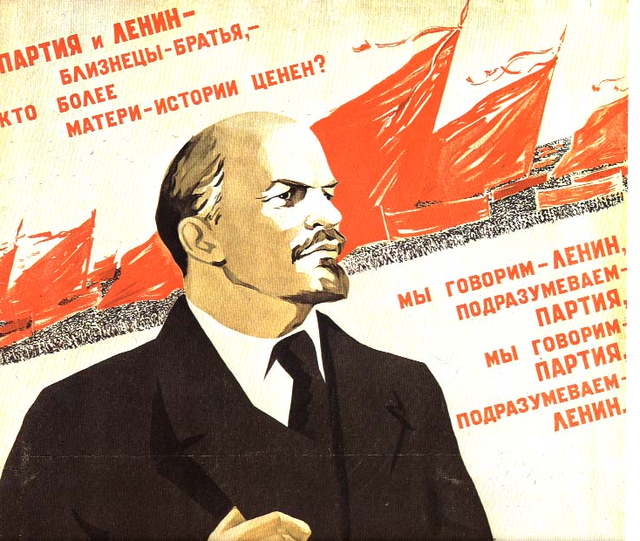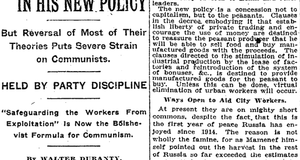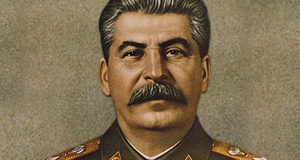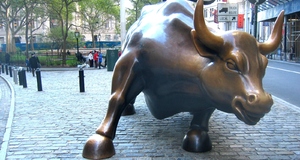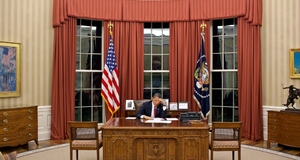Lenin's New Economic Policy: What it was and how it Changed the Soviet Union
By
2009, Vol. 1 No. 11 | pg. 1/1
KEYWORDS:
By the time 1921 came around, Russia’s economy had been maimed by the effects of War Communism. Socialism had not begun on a good note, and Vladimir Lenin was becoming concerned with the unfortunate state of the economy. His response to the poor economy he adopted and how he planned to improve it was called the New Economic Policy, or the N.E.P., which got its name from the fact that it was “new,” in comparison to the “old” Czarist economic “policy.” The N.E.P. was masterfully designed to bring capital into the state, which it did, and to help it prosper economically. However, some socialists believe it may have gone too far with its free-market economic style and possibly could have lead the Soviet Union into permanently possessing a capitalist economy, which would have destroyed the socialist priority. The original plan, however, was to have capitalism in place until the economy was strong enough to achieve socialism. After the Bolshevik Revolution in 1917, Vladimir Lenin and his party found themselves contemplating what would be appropriate for Russia’s economy which, at this time, was suffering from social challenges. Before the Revolution, there were basically only three classes of people: Peasants, Nobles, and Romanovs. Although certain reforms had been made, the peasants were still treated poorly and taken advantage of by the nobles. At the same time, World War One was taking place which not only negatively effected Russia’s economy but also had a great effect on Russian society as well.The first thing that was put into place was something called “War Communism.” The reason it was called this was because it was meant to be an economic method utilized during the Civil War, but in reality began before the war and remained in effect after the war until 1921. Right away, when the Bolsheviks seized power, Lenin underestimated the problems within the country, not only economically but socially as well. Within the first few months following the Revolution, all that could be changed was changed (Lenin, 5). The most profound of the changes to be made in those first months of the Soviet Union was the taking of private property from the capitalists: farmland, factories, mills, railroads, banks, and other properties with no compensation (Lenin, 5). Lenin made the mistake of taking what was the current government and its people and diving right into full-blown Communism, not realizing that they all were economically unequipped for such a conversion just yet (Caplan). Along with this, the unemployment rate sky-rocketed. Almost all manufacturing and retail was nationalized and peasants’ harvests were forcibly requisitioned by the state, with the idea that it would all go to the State whereupon it would be evenly distributed. Forced-labor policies were also set into place forcing both civilian and military persons to provide service to the state. As Lenin said when addressing the problems, as well as the obvious solution of reversion to capitalism, he talks about how the “ unprecedentedly dislocated country is just barely beginning to recover, is only just realizing the full depth of its ruin, is suffering the most terrible hardships-stoppage of industry, crop failures, famine, epidemics” (Lenin). Eventually the Bolsheviks came to realize that Russia was beginning to drown underneath this War Communism from a whole host of circumstances, such as famine, lack of resources, and disease due to malnutrition. With this Lenin admits that “We have risen to the highest and at the same time the most difficult stage of our historic struggle.” On April 25, 1921 Lenin introduced the Tax In Kind policy, which would replace the “surplus-food appropriation,” or the policy which assigned a certain amount of the peasants’ produce which the State was entitled to. The produce which was collected would go directly to the State and then be distributed to the rest of the country, in order to ensure that everyone had food. It seemed like a valid system, theoretically. However, once it was put into practice, the country soon faced a famine due to the fact that there were too many people and not enough food. The government was helpless to fix this. The Tax In Kind policy, which would replace the surplus-food appropriation system with a fixed tax (which the peasants would be informed of ahead of time), however, was meant to ease the burdens which War Communism had placed on the peasants and, therefore, improve their motivation to work. As Lenin put it, “The peasants will now set to work on their farms with greater confidence and with a will, and that is the main thing.” The Tax In Kind would not only give the peasants incentive to increase production, but it also gave them the freedom to sell what they produced on the market for profit, something that would not have been allowed under War Communism. Coincidentally Lenin realized, as Russia’s economy was falling through under the weight of instant Communism, that the peasants made up a majority of the population and although the government had been set up for the Proletariat, the fact of the matter was that only a small percentage of the population (not even 10%) made up an actual population of factory workers and most of the rest were peasantry. Therefore, they would have to be considered in this New Economic Policy because if they weren’t, just as with War Communism, the economy would continue to suffer. During the 2nd Congress of the Political Education Departments in October 1921 Vladimir Lenin began discussing the New Economic Policy and the need for its immediate application, due to the devastating effects of War Communism. It was concluded that the mistake was made when the Bolsheviks decided to resort right to Communism within the first months of victory, although the goal was to use capitalism as a kind of bridge between the petty bourgeoisie economic policy and the Communist economic policy. However, that was not the case and as a result Russia experienced acute food shortages, which lead to malnutrition, disease, and death; therefore effecting the working class and peasantry, therefore having a dire effect on Russia altogether. It was decided that the New Economic Policy was more of a “strategical retreat” than anything else. It definitely would not be a permanent thing, but just a way of relieving Russia from the burdens which War Communism had produced and, instead, replacing the procedures of food requisitioning and nationalization of agricultural land with a sort of free-market economy with the allowance of private business. As stated by Lenin, “economically and politically speaking the New Economic Policy completely ensures to us the possibility of building the foundation of a socialist economy.” It was meant to be based off of the existence of capitalism. Basically it would be a combination of the capitalist economy and the communist politics. Large businesses would still be nationalized, in order to ensure that the “petty bourgeoisie,” or the capitalist Imperialists, would not gain too much power over or get in the way of the growing Socialist society. Lenin believed that capitalism would lead to Imperialism, which is the entity which they had only just eliminated. The N.E.P. was a way to manipulate capitalism so as to ensure that capital would be a result of labors, but Imperialism would not be able to infiltrate the system and regain power. Aside from the Socialist twist, the New Economic Policy was intended for the Soviet Union to experience a temporary taste of capitalism in order to improve the economy so as to successfully introduce Communism. The New Economic Policy meant restoring capitalism considerably. As mentioned previously, the food appropriation system and food requisitioning policy would be abolished. In return, the peasants would be allowed to sell freely (for profit) that which they had left over after the tax had been collected (that tax would be small and affordable). Foreign trade and the leasing of enterprises would now be permitted as well (Lenin, 64). The plan of action would be to rebuild and reopen factories which had been left in ruin during the years of War Communism and have the proletariat class re-employed in these factories, which, it was decided, would produce products which could be bought and sold and were useful, those which would improve life and improve the State. As Lenin remarks on this the factories would would be engaged in the production of socially useful materials... not in profiteering, not in making cigarette-lighters for sale, and in other “work” which is not very useful, but which is inevitable when our industry is in a state of ruin” (Lenin, 66). One of the greatest concerns among the Bolsheviks was “Who will win, the Capitalist or the Soviet Power?” (Lenin, 65). Indeed there was a validated fear of the possibility of the Capitalists taking over and reverting, once again, back to an Imperialist government and economy. As Lenin said in this particular document, “the capitalist, whom we are allowing to come in by the door, and even by several doors (and by many doors we are not aware of, and which open without us, and in spite of us),” (Lenin, 65). There were two options, according to Lenin: Either the capitalists take over and drive out the Communists or capitalism is utilized by the proletariats and the peasants, while submitting and serving the State (Lenin, 66). There was always the chance that if capitalism overthrew Communism and became the dominant cause there could be, once again, the same old regime that was in previously in power, which would mean that all of the hard work of Lenin and his Party would have gone to waste and, in fact, would be to blame for the fall of Communism and the (technically) welcoming of the oppressive Imperialism, once again. Something that was greatly stressed in the proposal of the New Economic Policy was “The Principle of Personal Incentive and Responsibility.” As mentioned before, the N.E.P. would mean allowing for free trade among the peasants and allowing them to keep or sell (whichever they preferred) after they had payed the tax, which had been guaranteed to be of a small quantity. Either way, there was a great amount of trust and faith in which the State would be putting into its people. There was an underlying fear, as mentioned before, that capitalism would become too powerful and take over the Communist party and that was, of course, taken into consideration. The Soviet people were now expected to not only defend the Bolsheviks and the Communist Party, but defend the cause of Communism as well. They were expected to withhold Communist values and fight against the capitalists should they cause an uprising or be deemed as dangerous to the cause. As Lenin put it, “Whoever now departs from order and discipline is permitting the enemy to penetrate out midst” (Lenin, 71). To further ensure that this would not become a problem, the Soviet government discussed many tactics which would be applied in order to keep capitalism under control. During the 2nd Congress of Political Education Departments, which took place on October 17, 1921, Lenin went over some of the facts of these precautions by telling his party that, “Strict, stern measures were adopted, including capital punishment, measures that even the former government did not apply” (Lenin, 71). Although it is obvious, through deep analysis of his documents and the strong expression of his beliefs in Communism and against Imperialism and capitalism, it would seem to some that there was an almost paranoid anxiety of the capitalists. It’s not just that he acknowledges the dangers of capitalism and the inevitable chance that there will be those who will disagree with Communism, but there is undeniable evidence that this truly was a real fear for him. An example of this paranoia is when he is speaking about how the Soviet people will now have to work side by side with the capitalists, and how they will be hard to pick out of a crowd. But the fact that “They will squeeze profits out of you...” and that “they will enrich themselves, operating alongside of you” (Lenin, 72). Unfortunately the New Economic Policy would be short-lived because after Lenin’s death in January of 1924, Stalin’s infamous Five-Year Plans were instilled upon the Soviet Union. Immediately the New Economic Policy was abandoned; this would prove to be both good and bad. In a way, N.E.P. had, indeed, improved the Soviet economy, but only back to the levels at which it was during World War One. The peasants were meeting the expectations of the government (therefore, not complying with their part of the agreement on the conditions of the free-market style of economy) which meant that although progress had been made in comparison to the desperity of the days of War Communism, not enough progress was made. In Stalin’s mind, N.E.P had to go! The New Economic Policy was cleverly created curing a time of dire economic failure, famine, and unemployment. The mistake was made in transitioning straight from Imperialism to Communism, which, according to the basic economic and social laws, cannot happen. As a result, a new approach was made which incorporated the collective effort, capitalism, and service to the State all in one. Naturally the N.E.P. was not intended to be a permanent fixture in Soviet economy or politics, but rather something of a stepping stone, as well as a way to improve the economic state by the utilization of capitalism, but with a Communist twist: despite the free markets and the chance for free trade and sales, the economy would still be subservient towards the State and the main goal of the capital brought in by the N.E.P. would be to strengthen the State, its people, and its party in order to prepare them for the real deal: Communism. Once again using the wise words of the genius behind this intelligent plan, “We must see to it that everyone who works devotes himself to strengthening the workers’ and peasants’ state” (Lenin, 72). Through his New Economic Policy, we are not only able to get a glimpse into what could have been, but we also gain more of an understanding of the devotion, passion, discipline, and, almost, obsession, with the State, its well-being, and, most importantly, the Soviet People. One has to wonder, however: The New Economic Policy had only three years to develop. What if Lenin were to have lived longer, thus keeping alive the system of capitalism under Communism? This is something that is debated and questioned to this day. Devout Leninists would be obliged, even more than willing, to claim that had Lenin lived perhaps a decade longer the New Economic Policy, among many other things, would have thrived and perhaps the minor fallacies would have been corrected. Vladimir Lenin believed that, after having experienced the consequences of instant Communism, a stable, successful economy would be harvested with time, the length of which was unknown and had no limit. ReferencesAlfred G. Meyer, Communism (New York: Random House, 1984), 36-48. Dominick Salvatore, National Economic Policies (Westport: Greenwood Press, 1991) Karl Marx and Friedrich Engels, The Communist Manifesto, ed. Francis B. Randall, PhD (New York: Simon & Schuster Inc.) V.I. Lenin, Selected Works Vol. I, ed. A. Fineberg (New York: International Publishers) V.I. Lenin, Selected Works Vol. II, ed. A. Fineberg (New York: International Publishers) V.I. Lenin, Selected Works Vol. VII, ed. A. Fineberg (New York: International Publishers) V.I. Lenin, Selected Works Vol. VIII, ed. A. Fineberg (New York: International Publishers) V.I. Lenin, Selected Works Vol. XXXII, ed. Yuri Sdobnikov (Moscow: Progress Publishers, 1965), 133, 214, 366-367. V.I. Lenin, Selected Works Vol. XXXIII, ed. David Skvirsky and George Hanna (Moscow: Progress Publishers, 1966), 21-25, 60-66. V.I. Lenin, Selected Works in One Volume, (New York: International Publishers Co., Inc., 1974) 325-329, 640, 650-652. Nicholas V. Riasanovsky and Mark D. Steinberg, A History of Russia (New York: Oxford University Press, 2005), 484-485. Suggested Reading from Inquiries Journal
Inquiries Journal provides undergraduate and graduate students around the world a platform for the wide dissemination of academic work over a range of core disciplines. Representing the work of students from hundreds of institutions around the globe, Inquiries Journal's large database of academic articles is completely free. Learn more | Blog | Submit Latest in History |

